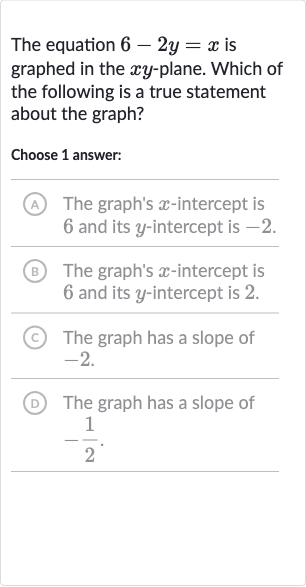AI tutor
Welcome to Bytelearn!
Let’s check out your problem:

The equation is graphed in the -plane. Which of the following is a true statement about the graph?Choose answer:(A) The graph's -intercept is and its -intercept is .B The graph's -intercept is and its -intercept is .(C) The graph has a slope of .D) The graph has a slope of .
Full solution
Q. The equation is graphed in the -plane. Which of the following is a true statement about the graph?Choose answer:(A) The graph's -intercept is and its -intercept is .B The graph's -intercept is and its -intercept is .(C) The graph has a slope of .D) The graph has a slope of .
- Problem Understanding: First, we need to find the slope and y-intercept of the graph of the equation . To do this, we should rewrite the equation in slope-intercept form, which is , where is the slope and is the y-intercept.
- Rewrite Equation in Slope-Intercept Form: We can start by isolating on one side of the equation. We'll subtract from both sides to get .
- Calculate Slope and Y-Intercept: Next, we divide both sides by to solve for . This gives us . Now we can see that the slope () is and the y-intercept () is .
- Find X-Intercept: To find the x-intercept, we set to and solve for . So, we have . Multiplying both sides by to get rid of the fraction, we have . Adding to both sides, we find that .
- Matching with the Options: Option (): The -intercept is , but the -intercept is not . So, option is not correct. Option (): The -intercept is , but the -intercept is not . So, option is not correct. Option (): The slope is not . So, option is not correct. Option (): The slope is . So, option is correct.
More problems from Write a quadratic function from its x-intercepts and another point
QuestionGet tutor help
QuestionGet tutor help
QuestionGet tutor help
QuestionGet tutor help
QuestionGet tutor help
QuestionGet tutor help
QuestionGet tutor help
QuestionGet tutor help
